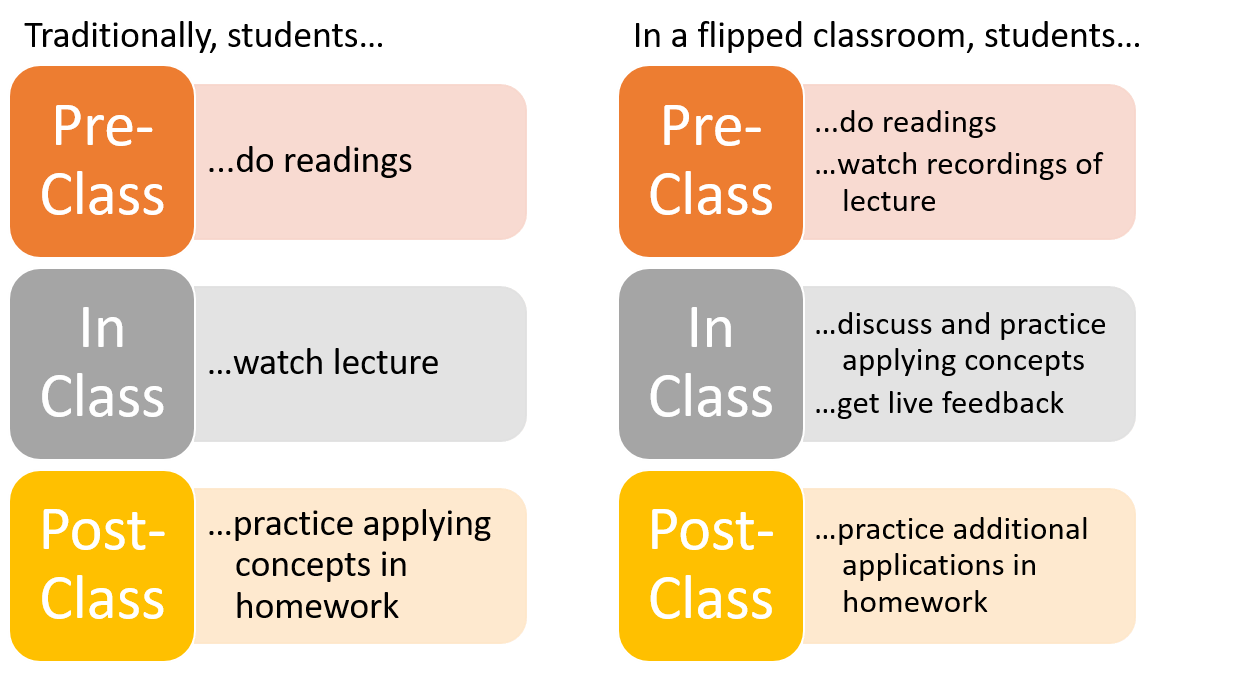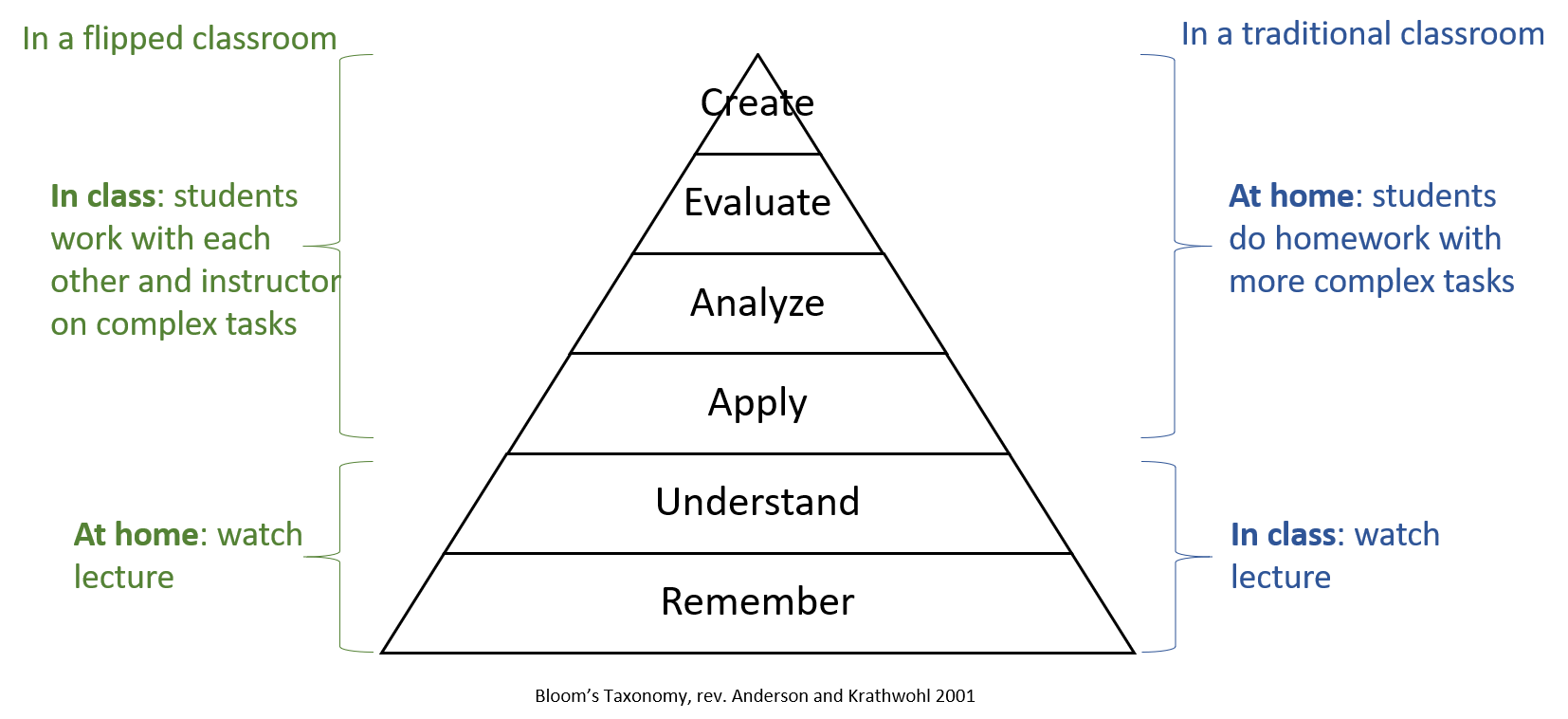What is flipping the classroom?
In a “flipped classroom,” students engage with new material before coming to class, so that more time in class can be spent on discussion, application, and other kinds of more active learning. You probably already do something like this if you assign readings for students before class. When you flip your classroom, you go one step further by recording your lectures and having students watch them before class, opening up even more class time for other activities. Your recorded lectures become a kind of textbook.

One of the most important things to keep in mind is this: you don’t need to flip your entire class. You might have good reasons for reserving some time in certain classes for lecture, and you certainly don’t need to flip everything at once.
Why flip?
The basic idea is to use the time when you and your students are meeting face to face in the most productive way possible, and to offload activities that don’t take best advantage of that face-to-face time–like reading a book or watching a lecture–to outside class. These tend to be activities that are less interactive and more preparatory for learning more actively and more deeply.
Put in terms of the hierarchy of learning created by UChicago’s own Benjamin Bloom, students work on lower order tasks like Remembering and Understanding out of class beforehand so that the time in class can be spent on more cognitively demanding tasks that might better benefit from real-time collaboration and feedback like applying, analyzing, evaluating, and creating.

So, the idea is that the face-to-face time becomes an opportunity for interaction and experimentation, instead of content delivery. It also gives students more agency and control when it comes to that content delivery: they can engage with content at their own pace, watching it as they like, pausing, rewinding, or rewatching. As a strategy, there’s some indications for improved student outcomes; see this meta-study for a survey of the evidence.
But should you flip your class?
At the same time, as that same meta-study also indicates, flipping can also pose challenges. Students need to be made aware of what they should be doing outside of class, how to get help, and the rationale for flipping. They will need some hand-holding and support. One common complaint among students, which comes from the sense that they aren’t supported, is that they’re now forced to “teach themselves.” On the instructor end, flipping an entire class can be a huge time investment, as it requires recording lectures and preparing in-class activities for every session.
In addition, flipping may just not be right for your class. The descriptions of “traditional classes” and “flipped classrooms” are something of a caricature. You may do some lecturing in your class, but you may still find ways to make it highly interactive and create opportunities for your students to practice those higher-order modes of thinking. On the other hand, recording a lecture and having students watch it beforehand doesn’t guarantee that students will understand it, or even watch it in the first place (anymore than they’ll necessary read and understand assigned readings).
Still, even if you shouldn’t flip your entire class, flipping can be good to think with.
- What do you see as the benefits of meeting in person? What do you value about those interactions?
- Does the way your students spend time in class and out of class reflect those values?
- Do you spend class time on lecturing and other kinds of content delivery? What do you see as the difference between exposing students to it in person and exposing students to it outside of class via a recording (but then having them come to class with questions)?
- Do your students understand why you’re using your face to face time the way you’re using it? Are they getting out of it what you want them to get out of it?
How do you flip your class?
To reiterate: you don’t need to flip your entire class. It’s not an all or nothing endeavor.
Firstly, it can be best to experiment at first by starting small and finding out what works for you and your students. If there are certain class meetings that really lend themselves to this strategy, you can start there.
Secondly, the goal isn’t to flip for the sake of flipping. It’s to do what makes the most sense pedagogically for the students. Given how you run your class, you may have good reasons for not wanting to record your lectures for certain class meetings.
So first, these might be good places to start:
- Are there lectures that students have difficulty understanding and might really benefit from being able to watch and review at their own pace?
- Are there classes where the lecture really eats into your interaction with the students, and their interaction with each other?
As you think about where you want to flip, you’ll also need to think about how you want to use that class time instead.
- What activities would you do in class so that students can learn or engage more deeply?
- How will the out-of-class content tie into the in-class activities?
You’ll also need to think about the full student experience:
- If you flip a class, what are you doing to the workload of your students? Are they now being given too much homework?
- Are you giving your students adequate support? Do they know why the class is flipped, what is expected of them, and where to get help?
- Are there any out-of-class activities you can build in to ensure they watch the recordings and let them practice their knowledge? Online quizzes, for example?
Once you identify where you want to flip, you’ll need to prepare and record your content, and then put it on Canvas for students. Read about “Chunking” for more on how to prepare your content. For more on how to prepare, and for help recording and getting it onto Canvas, please contact us.
Further resources:
- How do you flip a class? A simple, step-by-step guide on designing a flipped classroom. From the Faculty Innovation Center at UT Austin.
- Flipping the Classroom. An in-depth account of some of the principles of the flipped classroom. From the Center for Teaching at Vanderbilt University.
- Flipping your Class. A discussion of a range of topics, including student assessment; examples of flipped classes are included. From the University of Michigan Center for Teaching and Learning.